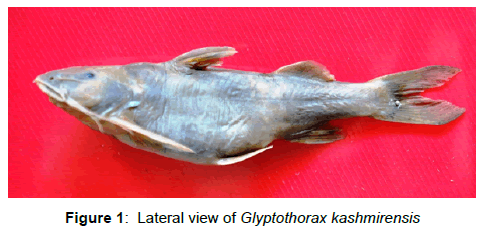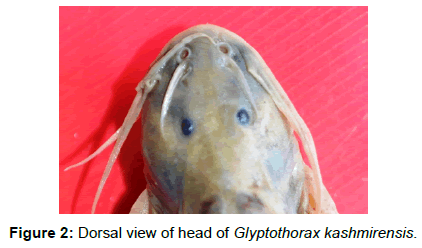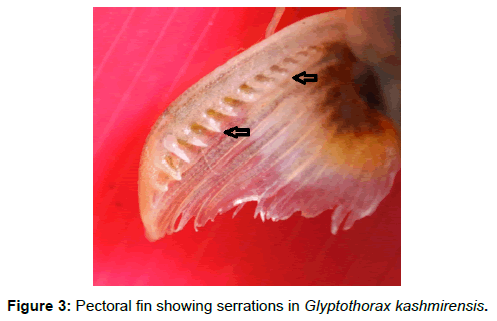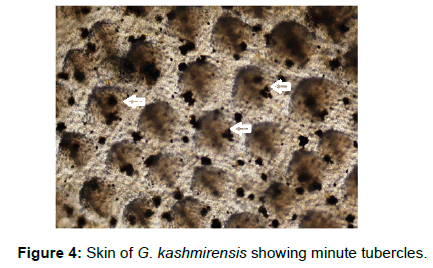Review Article Open Access
Threatened Fishes of The World: Glyptothorax kashmirensis (Hora, 1923) (Siluriformes: Sisoridae) A Mini Review
Singh R1, Md. Akhtar S2, Pandey N2, Mir JI2 and Sharma NK1,2*
1Department of Zoology, Hemwati Nandan Bahuguna Garhwal University, Tehri Campus Badshahithaul, India.
2Fish Nutrition Laboratory, Directorate of Coldwater Fisheries Research, Anusandhan Bhawan, India.
- *Corresponding Author:
- Sharma NK
Department of Zoology, Hemwati Nandan
Bahuguna Garhwal University, Tehri Campus
Badshahithaul, Tehri Garhwal-249199, India
Tel: +918755604715
E-mail: neerajksharma24@rediffmail.com
Received Date: October 06, 2015; Accepted Date: November 19, 2015; Published Date: December 02, 2015
Citation: Singh R, Akhtar S, Pandey N, Mir JI, Sharma NK (2015) Threatened Fishes of the World: Glyptothorax kashmirensis (Hora, 1923) (Siluriformes: Sisoridae) a mini review. J Fisheries Livest Prod 3:147. doi:10.4172/2332-2608.1000147
Copyright: © 2015 Singh R, et al. This is an open-access article distributed under the terms of the Creative Commons Attribution License, which permits unrestricted use, distribution, and reproduction in any medium, provided the original author and source are credited.
Visit for more related articles at Journal of Fisheries & Livestock Production
Abstract
Kashmir catfish, Glyptothorax kashmirensis, is a critically endangered fresh water fish species in Asia. Wild populations are severely declined due to habitat loss (breeding and nursery grounds), dam construction, overexploitation and introduction of exotic species leading to an alarming situation, which deserves high conservation consideration. The present paper enlightens the previous work done and recommends conservation actions that should be taken into account towards the preservation of the wild population of G. kashmirensis.
Keywords
Glyptothorax kashmirensis, Kashmir, Critically endangered, Conservation, India
Introduction
Common name
KashmirGlyptothorax, Kashmir catfish [1-3]
Local name
Nayid (Kashmiri) [4]
Justification
Glyptothorax kashmirensis is a benthopelagic freshwater fish belongs to family Sisoridae [5,6] and known for its good taste and has local trade value [7]. The catfish is found attached to small or large boulders and rocks or rocky stream beds in fast flowing torrential hill river and streams. Due to construction of several dams (which contributes to habitat alternation) in area of species occurrence negatively affect the population in several locations due to which the species in now under critically endangered category of IUCN [8], predicting a decline of greater than 80% over the next five to ten years if present treats (damming, introduction of exotic species, overexploitation, etc.) continuous in future [9]. So, immediate efforts are needed to sustain the wild population of G. kashmirensis.
Conservation status
Critically Endangered (A3ce ver 3.1) as per IUCN guidelines [8,9].
Importance
It is a commercially important food fish in Asian countries because of its relished taste and also involved in local trade [7].
Identification
Body elongated and compressed laterally with greyish or dark brown from the dorsal side and light yellow or somewhat whitish from the ventral side (Figure 1) [4,10]. Mouth broad and inferior with papillated lips (Figure 2). Dorsal and pectoral including ventral fin is white in outline [11]. Colouration of fin base is light yellow. Four pair of barbels is present. Dorsal (6-7 serrations) and pectoral spine (12-13 serrations) are serrated internally (Figure 3) [4,12,13]. A longitudinally striated thoracic adhesive disc (adhesive apparatus) with oval central pit is present which differentiate it from other congeners [4,14,15]. Caudal fin forked deeply with lobes of equal length. Skin granulated with minute tubercles (Fig. 4). Fin rays: D I-5, P I-8-9, V I-5, A II-6, C 17-18 (Current study); D I-5, P I-8-9, V I-5, A II-6 [2] and D. I, 6; P. I, 8-9; V. I, 5; A.III, 7-8; C. 17 [13].
Distinguishing features
Glyptothorax kashmirensis is distinguished from congeners in having a combination of the following characters: length of dorsal-fin base 9.36-11.23 % TL, dorsal fin when appressed not reaching anterior origin of adipose fins, maximum body depth near dorsal fin origin 15.2-18.4% TL, minimum body depth near caudal fin base 4.24-8.50 % TL, eye diameter 9.12-13.28 % of HL, pre- orbital length 50-62.80 % of head length, head height 50-61.57 % of HL, dorsal fin with 5 branched rays, dorsal spine smooth, head and body granulated [4,11,13,15].
Population
The population of G. kashmirensis is continuously decline at a rate of approximately 5 % (in 15 years) foretold to be affected in the next 5-10 years from dam construction (together with the previously built Mangla dam) and habitat destruction [7,9]. Being fast flowing specialist in torrential hill rivers and streams, dam construction will modify its habitat irretrievably affecting population drastically. Furthermore, release of exotic species (creates competition for food, space, etc.) by fisheries department to their natural environment may drive the species to local extinctions in a number of or most locations [9]
Distribution
Native to Asia [11]. Present in Indus basin in India [15-17] and Pakistan [3,12,13,18-21] including Kali Gandaki in Nepal [22].
Habitat and Ecology
Complete data on its biology is still scarce; however, few reports are available in the previous literature. G. kashmirensis is a benthopelagic hill stream fish inhabits cold and fast flowing water (rheophilic species) with a substrate of sand/gravel and rocks [5]. Feeding habit is omnivorous and a bottom feeder in nature [7,23]. This species feeds on benthos and zooplanktons [24] and spends most of the time burrowing into the gravel bottom but comes to the surface during heavy rain and catch is greater during the rainy period.
Reproduction
G. kashmirensis breeds during June and July in lower reaches of the River (Jhelum) on gravel/ sandy beds and roots of somewhat submerged plants [23]. This is to avoid mortality of eggs, larvae and fry caused by high water currents in upper reaches of the river. Fecundity of G. kashmirensis ranges from 692 to 1392 with an average value of 1070 eggs (aveg. length = 9.4 cm and Weight = 12.29 gm). The number of eggs per gram of body weight is approximately 87 [23]. Mark sexual dimorphism is present in this species [15].
Length Weight Relationship
Length–weight relationships (LWRs) are extensively used in fisheries studies for assessing the weight for a given length of a distinct fish and the biomass when the length–frequency distribution is known [25,26]. Sharma et al. [27] firstly studied the length-weight relationship of Glyptothorax kashmirensis from Poonch River, Western Indian Himalaya and reported the value of ‘a’ as 0.0147 and 3.02 for ‘b’ which suggests positive allometric growth in riverine population. Maximum reported size of fish is 14.84 cm (W = 48.19 g) [27]. Other than this, there is no record of such relationship in the literature.
Threats
The populations of G. kashmirensis from rivers have severely declined or are on the verge of extinction due to habitat loss (breeding and nursery grounds) and the potential introduction of exotic invasive fish species. Being a fast flowing river specialist, construction of the dam will alter the flow regime of the river that ultimately affects the fish population drastically [7,9]. Other anthropogenic activities, pesticides run off, and overexploitation (by indiscriminate fishing) and local trade are also reasons for declining the population of this species [7]. Due to several proposed dams on River Jhelum, there is a potential threat to species as well as its habitat in next 3-5 years. A foretold decline of more than 80% over the next five to ten years is expected due to the above severe, constant threats [9]. A comprehensive strategy, therefore, needs to be evolved for conservation.
Conservation Recommendations
There should be a legitimate provision for discouraging illegal techniques of fishing, such as the use of hazardous chemicals, dynamite, electrofishing, the use of small mesh-sized nets and fishing during spawning season. Adequate care must be given to the protection of the spawning and nursery gravel grounds of species. A river/ reservoir associated hatchery is recommended to replenish the losses resulting from the vanishing of the natural breeding grounds. As Glyptothorax kashmirensis is naturally adapted to inhabit fast flowing waters, any obstruction like construction dam will alter the regime of flowing water dramatically which eventually affect its population. So, less number of dams should be proposed in the area of species occurrence. Moreover, artificial breeding and ranching programs should be recommended in the area of species occurrence to restore its declining population. Awareness programmes with local people’s participation should be organized to disseminate the importance of conservation of this species. Enhancing the habitat by tree planting to upsurge shelter cover, shade and drift food is also another option. The use of the combined approach, such as morphometry, genetic and other biological indicators (e.g. growth pattern of scales and otoliths, fatty acids and trace elements, reproductive biology, stock structure, etc.) should be deliberated for whole assessment. Awareness programmes with local people’s participation should be organized to disseminate the importance of conservation of this species. In overall, no action is taken by the government as well private agency until date regarding conservation of concerned species. Therefore, research programmes by students and scientist’s participation in the field of fisheries should be planned to conserve the species under high risk of extinction.
Acknowledgements
We acknowledge the local fisherman for their valuable help during the study period.
References
- Wu HL, Shao KT, Lai CF (1999) Latin-Chinese dictionary of fishes names. The Sueichan Press,Taiwan:1028.
- Chinese Academy of Fishery Sciences (2003) Chinese aquatic germplasm resources database
- Rafique M, Khan NUH (2012) Distribution and status of significant freshwater fishes of Pakistan. Records: Zoological Survey of Pakistan 21: 90-95.
- Kullander SO, Fang F, Delling B, Ahlander E (1999) The fishes of the Kashmir Valley. River Jhelum, Kashmir Valley. Impacts on the Aquatic Environment: 99-168
- Froese R,Pauly D (eds.) (2015) FishBase. World Wide Web electronic publication.
- Eschmeyer WN (2015) Catalog of fishes.
- Molur S, Walker S (1998) Report of the Workshop “Conservation Assessment and Management Plan for Freshwater Fishes of India”, Zoo Outreach Organisation, Conservation Breeding Specialist Group, India, Coimbatore, India. 156.
- The IUCN Red List of Threatened Species (2015).
- Ng HH (2010) Glyptothoraxkashmirensis. The IUCN Red List of Threatened Species.
- Hora SL (1923) Notes on Fishes in the Indian Museum. V: On the composite genus Glyptosternon McClelland. Records of the Indian Museum 25: 1-44.
- Jayaram KC (2010) The freshwater fishes of the Indian region. Delhi: 2nd edn. Narendra Publishing House, India: 616.
- Rashida MR, Saleem M (1996) A contribution to the systematics and biology of Glyptothoraxkashmirensis Hora (Pisces: Sisoridae) from Pakistan and Azad Kashmir. Biologia, Pakistan 42: 59-60.
- Javed MN, Kalsoom S, Pervaiz K (2013) Catfishes of the genus Glyptothorax Blyth (Pisces: Sisoridae) from Pakistan. Biological Society of Pakistan 59: 69-83.
- Silas EG (1960) Fishes from the Kashmir valley. Journal of Bombay Natural History Society 57: 66-77.
- Talwar PK, Jhingran AG (1991) Inland Fishes of India and Adjacent Countries, Balkema AA, Rotterdam (eds.). Reviews in Fish Biology and Fisheries, springer.
- Menon MAS (1955) Notes on fishes of the genus Glyptothorax Blyth. Records of the Indian Museum 52: 27-54.
- Das SM, Nath S (1971) A revision of fishes from Jammu province. India, Ibid 8: 1-22.
- Mirza MR, Hameed K (1974) Sisorid fishes (Osteichthyes, Sisoridae) of Pakistan and Azad Kashmir. Biologia, Pakistan 20: 83-97.
- Ahmad MF, Khan SA, Mirza MR (1976) A checklist of the freshwater fishes of the Indus Plain, Pakistan. Biologia 22: 229-260.
- Mirza MR, Janjua MH (1985) Fishes of Muzaffarabad, Azad Kashmir. Biologia 30: 229-244.
- Mirza MR, Ali I, Javed MN (1993) A contribution to the fishes of the Kurram Agency, Pakistan. Punjab University Journal of Zoology 8: 37-40.
- Shrestha J (1999) Coldwater fish and fisheries in Nepal. Fisheries Technical Paper 385: 13-40.
- Nath S (1994) Recent advances in fish ecology, limnology and eco-conservation. Daya Books 3: 71-78.
- Fishbase (2010) Fish species in the Indus River Basin.
- Froese R, Thorson J, Reyes RB (2014) A Bayesian approach for estimating length-weight relationships in fishes. Journal of Applied Ichthyology 30: 78-85.
- Sharma NK, Mir JI, Singh R, Akhtar MS, Pandey NN (2015) Length–weight relationships for eight fish species from the Ravi River, north-western India. Journal of Applied Ichthyology 31: 1146-1147.
- Sharma NK, Singh R, Pandey NN, Akhtar MS, Mir JI (2015) Length–weight relationship of two fish species from Poonch River, Western Indian Himalaya: Glyptothoraxkashmirensis (Hora, 1923) and Crossocheilusdiplochilus (Heckel, 1838). Journal of Applied Ichthyology 31: 1144-1145.
Relevant Topics
- Acoustic Survey
- Animal Husbandry
- Aquaculture Developement
- Bioacoustics
- Biological Diversity
- Dropline
- Fisheries
- Fisheries Management
- Fishing Vessel
- Gillnet
- Jigging
- Livestock Nutrition
- Livestock Production
- Marine
- Marine Fish
- Maritime Policy
- Pelagic Fish
- Poultry
- Sustainable fishery
- Sustainable Fishing
- Trawling
Recommended Journals
Article Tools
Article Usage
- Total views: 13134
- [From(publication date):
December-2015 - Mar 29, 2025] - Breakdown by view type
- HTML page views : 11969
- PDF downloads : 1165




